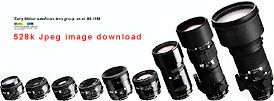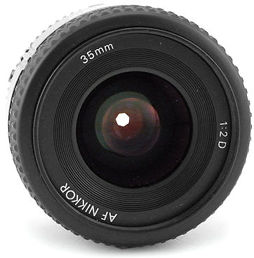Part One:- Among all the Nikkor wideangle lenses, generally the 35mm focal length can be considered as closest match to normal (standard) lens where usually we referred those lenses with a focal length from 45mm to 60mm under the "standard lens" category. The optical behavior of 35mm wideangle lenses usually produce a natural perspective but they have a wider picture angle than 50mm lenses, making them ideal tool for moderate wideangle photography. Because of its wider coverage of 63° (provides approx. twice the image area of the 50mm) and a slightly extended depth of field yields, 35mm foal length is often used for a wide scope of snapshots and general photography. In addition, this lens is equally suited for flash photography since most of the flash units offered by major labels are usually designed include picture angle up to about 60 degrees or more. Perhaps, the most important aspect for practical usage for lenses of 35mm prime (fixed focal length) wideangles is their unique characteristic of providing a moderate perspective with a reasonably fast opening aperture and this particular focal length and it was quite a popular lens of choice for wideangle photography during those manual focus days. It is versatile, easy to operate and a great consideration for both indoor and outdoor available light shooting where you need just a touch more coverage but not excessive picture coverage so as to maintain relationship of the subject in natural environment. It also offers slightly broader depth of field than the normal lens at the same aperture and focus setting. Nikon's 35mm MF versions are consisted of three great options, namely:- an incredibly bright Nikkor 35mm f/1.4s fast speed wideangle (Seen a modified Nikkor 35mm f/1.4 for Nikon F3 NASA 250 SLR camera yet ?), followed by a Nikkor 35mm f/2.0s lens alternative and lastly a highly affordable Nikkor 35mm f/2.8s lens. These are the last of the manual focus batch with an Ai-S lens spec during end of the first quarter of '80. Below is a brief background how the Nikkor 35mm wideangle had evolved itself to current state.
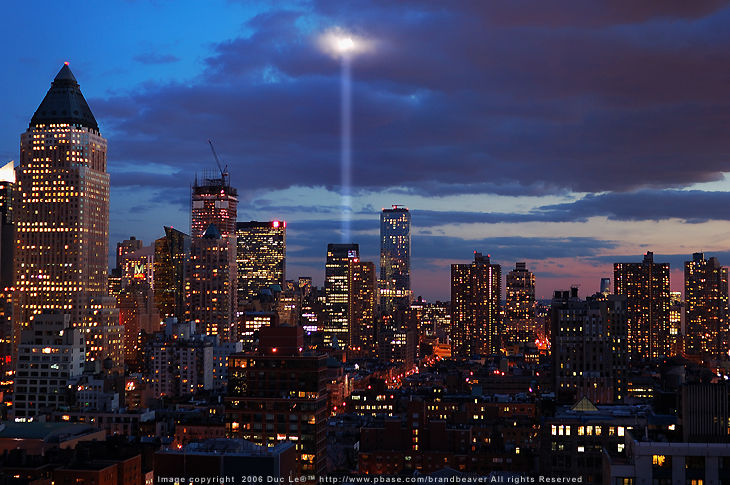 |
Landmark@911 |
Background & a quick reference on Version History During the early days of Kwanon (canon original name) and Hansa series rangefinder camera also used a few Nikkor 5cm standard lenses but I am not sure if Nikon has ever produced any 35mm wideangle for Canon thus far. The first Nikkor lenses with a 35mm focal length can be traced back to the Nikon 1 of 1948; it was among the first 5 original Nikkor lenses that offered with the said original Nikon Rangefinder Nikon 1 camera model (others were 50mm f/3.5, 50mm f/2.0, 85mm f/2.0 and 135mm f/4.0).
But after Nikon decided to launched their own label (Nikon 1), the W-Nikkor 1:3.5 f=3.5cm (35mm) introduced during the occupation era (MIOJ) uses a simple 4 element design; the optical system has remained unchanged even when Nikon has kept updating the physical design of the W-Nikkor all the way to 1954 (the last may be looked like the second photo below, but it has a "C" which signifies lens was coated and may suggest it was version introduced at late stages). In between, a variation of W-Nikkor 3.5cm with a faster lens speed f/2.5 (shown at third photo from below) was being released in 1952. The fastest among all available option of the early series of Nikkor 35mm wideangle lenses for Nikon rangefinder camera was a W-Nikkor(C) 1:1.8 f=3.5cm (shown at fourth photo below) which was made available to Nikon photographer during the late '56. I don't have another image for an odd Stereo-Nikkor 1:3.5 f=3.5cm lens to show all of you here but it was also part of the early 35mm wideangle lens designed for the Nikon rangefinder camera series.
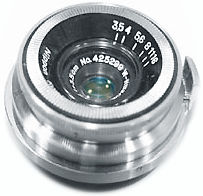 |
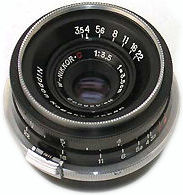 |
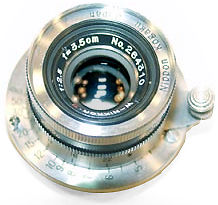 |
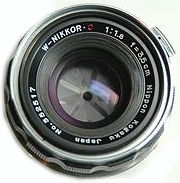 |
Photo Credit: Images of 1st and third courtesy of Mr. RON's EBAY STORE ; Images of 2nd and forth courtesy of ADORAMA.com. All Images copyright © 2006. All rights reserved. I Please respect the visual property of respective image contributors. |
|
|
|
|
|
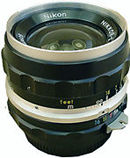 |
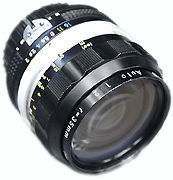 |
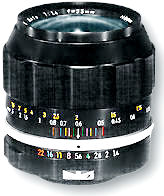 |
 |
 |
When the reflex Nikon F was eventually introduced in 1959 with a clear advantage of direct reflex viewing system it deployed with; the 35mm wideangle lens group went through a radical change in adopting a retrofocus optical design. |
I attached two PDF files of the early versions of these 35mm lenses for you to compare the differences between the optical structure between the rangefinder as well as reflex versions of the early Nikkor 35mm wideangle Further, I display some of the newer reflex versions below which comprised of a pre-Ai era (1972-75); Ai lens spec versions that were introduced during 1977/78 where it relates.
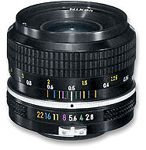 |
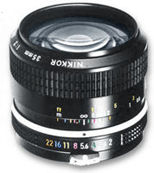 |
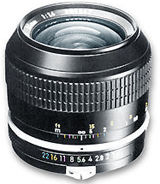 |
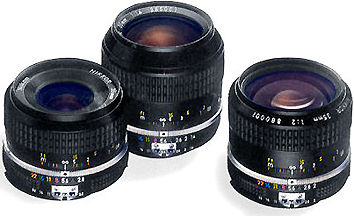 |
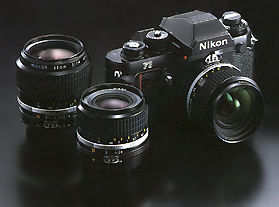 |
The last batch of the evolution with the manual focus 35mm prime wideangle lenses was the Ai-S lens update occurred beginning in 1981. This update has permitted the 35mm lenses to enable exposure modes like Shutter Priority AE and Programmed AE never before* possible for Nikon photographers. Among other interesting things that related to lenses at 35mm focal length was, Nikon also has an alternative PC-Nikkor 35mm f/3.5/2.8 as well as a lightweight, compact Series E-35mm f/2.8s wideangle for the Nikon EM/FG/FG20 SLR cameras. In relation to optical innovation; The Nikkor 35mm f/1.4(s) has been widely regarded as one of the best wideangle designed for 35mm photography; and it was also the world's fastest 35mm lens. Lastly, the 35/1.4 was also the first Nikkor lens being treated with NIC lens coating process. Both the alternate Nikkor 35mm f/2.0s and Nikkor 35mm f/2.8s lenses other than offering a good performance /price ratio, they also permit an extreme magnification ratio up to 7X when reversibly mounted. |
* Nikon used to offer a device (DS-1/2, DS-12 EE aperture Control Unit) specifically for the old Nikon F2, to permit semi automatic Shutter priority AE with the mechanical classic of various Nikon F2 SLR models).
The brief summary on the background of Nikkor 35mm lenses may provide you with a clue how the lens type of Nikkor 35mm wideangle has evolved itself to its current autofocus state. What I am trying to suggest is to alert you not to ignore the experience in how Nikon developed their 35mm wideangle autofocus version as it carries with a rich tradition behind its development. That is all.
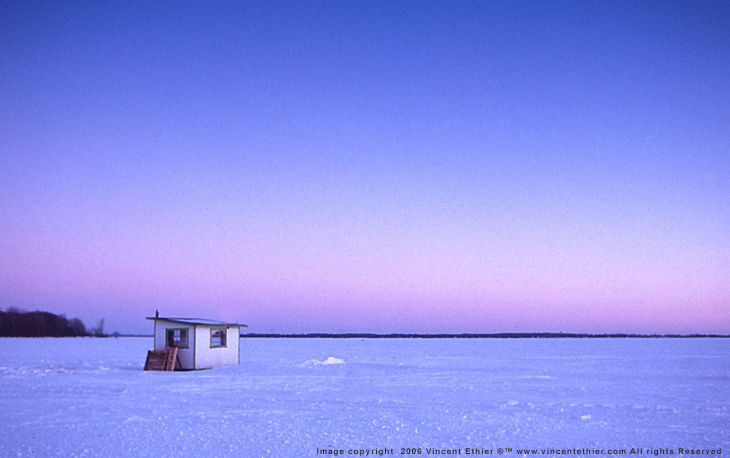 |
Absolute still Series ... |
![]()
Part
Two:-
Nikon Autofocus (AF) Nikkor
35mm f/2.0s fixed focal
length wideangle lens
Marketed 1989; Discontinued: 1995
The
autofocus version of the prime AF Nikkor 35mm f/2.0s was released barely a few years
AFTER the first
generation of the AF Nikkor lens group was being first introduced in 1986. The slight
delay in introducing the lens saw some benefits on by-passing the poorly designed
on the exterior appearance as exhibited among the early generation of the autofocus
Nikkor lenses. I am not sure why during theta time Nikon had delayed the launching
of this prime 35mm wideangle but I guess it had to do with the market's attention
were more focused on development of zoom lenses during that era and perhaps Nikon
saw no necessity in hurry for an autofocus prime wideangle lens as most wideangle
Nikkor autofocus zoom lenses available during that stage already had this focal length
well covered in their zoom range. So, by learning from the early negative responses
accumulated from the market, the AF Nikkor 35mm f/2.0s wideangle lens was actually
introduced with some improvement done and it was less apparent with duplication of
the weaker presentation as found on all those early AF Nikkor lenses.
I guess one of the area Nikon had done a reasonably good job on the design of this wideangle was the replacement of a new double rows hard rubberized covered manual focusing ring which changed the negative impression, It was not very wide but adequate for good use as manual focusing was a secondary feature in this autofocus lens. It was a clear departure from the thinly, narrowly ridged plastic ring as found on other early series, for an example CLICK here to compare the design used on the first version of the AF Nikkor 24mm f/2.8S and you probably will understand why consumers had kept resisting to invest into Nikkor AF lenses during those days. Next, to help the 35mm wideangle lens to sell, Nikon has chosen a faster lens speed of f/2.0 instead of f/2.8 as it was the fastest prime wideangle available during that early stage. Next, the AF 35mm f/2.0s Autofocus Nikkor lens was a new lens designed from ground up by Nikon. I am showing you a few pictures below, from the front diameter, you will probably notice the lens was actually a redesigned wideangle rather than adopting the similar measure for the AF Nikkor 24mm f/2.8S and AF Nikkor 28mm f/2.8s which actually were using an easy path of direct migration from the respective manual focus versions. |
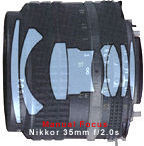 |
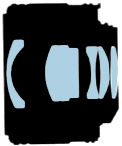 |
Combining both excellent factors in its optical resolution and an affordable price objective, I always thought the MF Nikkor 35mm f/2.0s was a very good wideangle, but seemingly the 8 elements in 6 groups old manual focus lens was not good enough to convince Nikon it was good for a direct migration; so, a new optical design of a 6 elements in 5 groups was used in the autofocus version. This original attempt has enabled the AF 35mm focuses closer than the predecessor to 0.25m (0.85ft) (from 0.3m MF 35/2.0) with improved magnification ratio of 1/4.2 (AF 35 f/2.0) from 1/5.7 (35/f2.0). Some online web resources have suggested a few of the early AF Nikkor 35mm f/2.0s made between 1989 - 2001 may exhibit lubricant leakage and Nikon offered free maintenance for lenses that affected; I have no clue of this episode; perhaps may be you can verify this. |
Credit: Image(s) displayed here are courtesy of chrissyfrousiakis® where I spotted these picture from his EBAY STORE. Image(s) copyright © 2006. All rights reserved. |
The AF Nikkor
35mm f/2.0s has no other alternate consideration in lens speed selection to choose
from within the AF Nikkor lens group, I always wonder WHY Nikon never brought the
classic MF
Nikkor 35mm f/1.4s
as an autofocus wideangle but rather, Nikon had retained the Ai-S manual focus Nikkor
35mm f/2.0s as an purchase consideration. Canon was smarter in comparison, they have
introduced two prime wideangle lenses for EOS users namely Canon EF 35mm f/1.4L USM and EF 35mm f/2.0 AFD, each with distinctive
features and price categories to attack Nikon's sole offer at this specific focal
length. I guess it is all boiled down to commercial viability as demands for prime
wideangle 35mm lenses was not in great demand for the last few decades. Anyway, all
along I didn't owned any AF 35mm prime, but a friend of mine who does on and off
showing me some pictures taken with this Nikkor AF wideangle. It still delivers the
same optical quality one expects how a Nikon wideangle would deliver. I feel the
contrast is slightly on the high side but shadow details are holding very well. Perhaps
may be the pictures taken was not what I wish to publish here as they are general
PR pictures (Sorry..man); but I will try to seek for some good illustrative photos
to showcase here later. Well, I am opened to this and so if you have some good pictures
to share, so mail me fro consideration.
![]() Part
Three:-
Part
Three:-
Nikon Autofocus (AF) Nikkor 35mm f/2.0D fixed focal length wideangle lens
Marketed 1995; Discontinued: Current model as at 11.2006
After
the introduction of the Nikon F90(x) (N90(s)); and along with a
broad scale general lens updating program conducted by Nikon, the AF Nikkor 35mm
f/2.0s wideangle lens also had gone through a round of lens update and this probably
could have been occurred around March, 1995 where a distance sensor has been incorporated
within, enabling compatible Nikon SLRs that offer 3D Matrix Metering system for an
improved level of metering and exposure accuracy. The AF-D Nikkor 35mm f/2.0D is
marginally larger than the non-D predecessor but it weighs slightly lighter at 205g
(non-D lens weighs at 215g). Other than these, it is an exact replication of the
non-D predecessor.
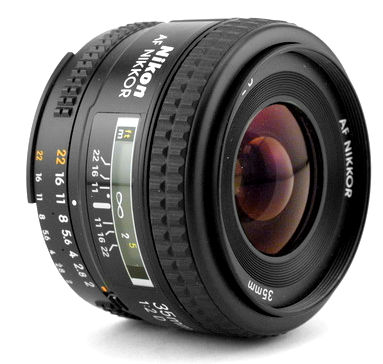 |
In general, it may require some guts and a cash-filled wallet for any previous owner just to upgrade his older version into a D-spec 35mm moderate wideangle lens again simply because now it comes with a compatible 3D-Meter feature. Reasons being, Nikon has released a long series of high performance wideangle zoom lenses since then where the sheer convenience of varia-angles zooming and zoom range/ratio can easily make this fixed focal length 35mm wideangle pale in comparison of its basic lens specification as well as practical usage; thus, by reverting back to invest into a fixed focal length 35mm wideangle lens would certainly require a logical thinking to do so. Further, 35mm may not be entirely an absolute MUST wideangle lens because there are other options available if a fixed focal length is a priority in your investment consideration. For an example, considering its moderate picture angle is tighter than a comparing AF Nikkor 28mm or even a 24mm ultrawide wideangle, it is less appealing to be an all round wideangle lens. BUT as I had stated earlier in the previous chapter, the AF 35mm f/2.0D does have a an element to convince a few Nikonian in its affordability as well as a fast lens speed of f/2.0. The lens speed factor in particular, makes it almost a full f-stop faster than any of the available mid range AF Nikkor wideangle lens group (except for the incredibly fast speed AF Nikkor 28mm f/1.4D which costs a bomb as a prime wideangle lens). |
Credit: Image courtesy of Laura Kornylak ® <shutterblade@comcast.net> from shutterblade*com where the Company has a website on its own. Image copyright © 2003. All rights reserved. Please respect the visual property of the contributing photographer.
With its moderate 62° field of view, the AF Nikkor 35mm wideangle lens can be used for a wide variety of personal photographic topics/usage. The reasonably fast, constant lens speed of f/2.0 may not be an ultimate large aperture lens to being you shooting in pitch darkness but other than offering an excellent property for handheld, it may help you to tackle most available light photography with some good camera/lens support during shooting. If use it wisely and creatively, this AF-D Nikkor 35mm wideangle lens can retain a sense of moderate depth where the wideangle lens effect is not as distinctive as other wideangles or ultrawides. Optically, although the lens doesn't look very appealing as as f/2.0 optic as has a small front lens element diameter (it is very similar to the manual focus Nikkor 35mm f/2.8s in external appearance) but the new optical group adopted by Nikon for this AF-D Nikkor 35mm wideangle provides excellent correction of curvative. The AF-D version carries the extra benefit of using the improved lens coating (SIC) that delivers high contrast but very natural, true to life pictures. Further, the close focusing capability of this lens perhaps should be given some attention to explore its potential by combining close-up photos with a wideangle effect. There are three marked depth of field scales of f/11, f16 and f/22 (yes, it has thoughtfully feed with a smallest aperture of f/22 which enhance the usage of depth of field control and manipulation such as for scenic, products as well as close-up etc.). So, all these factors would make it a lightweight travel companion wideangle lens esp. when use it with a compact Nikon SLR bodies such as Nikon FM2N, Nikon FM3A, Nikon F3HP and singularly with other bare basic autofocus film or digital based Nikon SLR camera body.
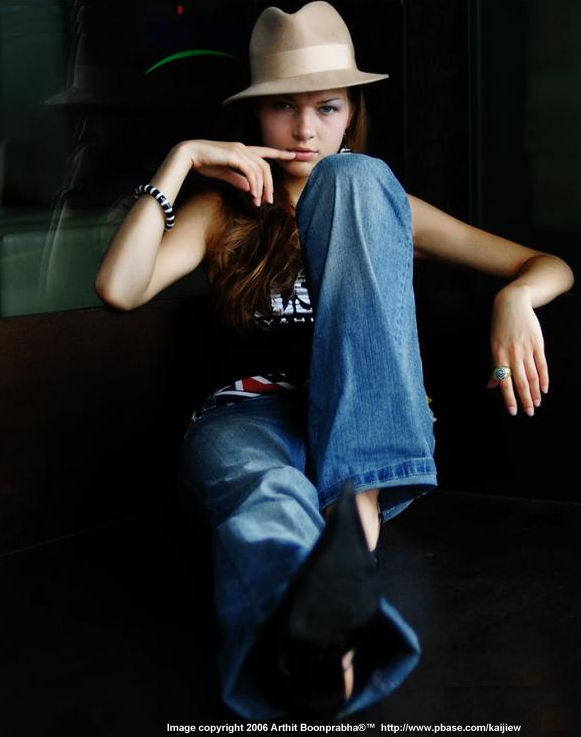 |
Hot summer night.. |
 |
For an instance, that friend of mine who often likes to use it with his Nikon F100 where he thinks the autofocus and lens lens handling property for this AF Nikkor 35mm wideangle is simply excellent. According to him, the noise level for AF is barely noticeable and AF is incredibly fast which has helped responsiveness to sudden events along the way. Further, he felt it makes a great companion for street photography as well as candid in or outdoor because the lens speed has enabled many picture taking opportunities Well, if a lens can make someone a proud owner and yet trying to convince others - it must be having its good more than bad, huh ? |
Well, except for the MF 35mm f/2.0 I used to own a piece and perhaps anticipating a possible AF-D Nikkor 35mmf/1.4 in the future (hopefully if ever Nikon delivers it will not be a G-spec AF Nikkor as I have other MF bodies to share); admittedly I am not a big fan of this AF Nikkor YET and wouldn't rush out to the shop to get one solely based on a few positive feeds, but I do notice it also has a 52mm filter attachment size, making it easy sharing with other filter accessories, am I realistic enough when come to choose my lenses ? I guess so... But for whatever reasons, for those who may be still having the inner desire to own an original autofocus Nikkor 35mm wideangle lens with a native AF-D lens spec - just go ahead - as I said, Nikon doesn't introduced this Autofocus (AF) Nikkor 35mm f/2.0D wideangle lens to make up the numbers in their autofocus Nikkor lens family. It has its other appealing elements to conclude it as an excellent autofocus wideangle. For manual focus Nikon SLR camera users, the AF Nikkor 35mm f/2.0D retains full backward compatibility with any of your Nikon bodies as long as they have a minimum specification of Ai to enable full aperture exposure measurement as well a enabling capable MF Nikon bodies for Programmed and Shutter Priority AE control. The manual focusing ring which has been designed narrower but as this AF-D 35mm wideangle is intended for autofocus; inevitably, manual focusing has been compromised slightly. However in terms of lens functionality, it will deliver its purpose as your useful 35mm wideangle lens.
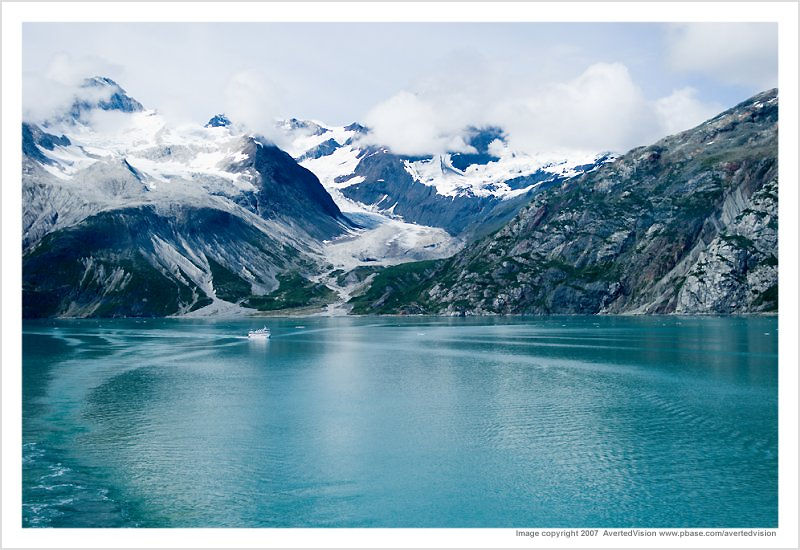 |
scenic cold mountain |
![]()
Technical
Specification
for Autofocus (AF) Nikkor 35mm f/2.0D wideangle lens (applicable to earlier
non-D version):-
Type of lense: Autofocus/Manual
focus Nikkor fixed focal lens with built-in CPU and Nikon bayonet mount
Focal length: 35mm; Maximum aperture: f/2.0; Minimum Aperture:
f/22
Lens construction: 6 elements in 5 groups
Picture angle: 62° (35mm);
44°
Nikon DX digital SLR format cameras.
Diaphragm: Fully automatic,
Distance scale: Graduated in meters and feet/inches from 0.25m (0.85') to
infinity (OO)
Distance information: Output into camera body with CPU interface system NOT POSSIBLE for earlier Non-D version, but possible to the D-version;
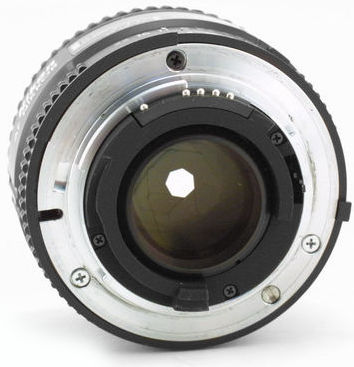 |
Aperture scale: f/2.0 to f/22 on both standard and aperture-direct-readout scales |
 |
SNOW white ... |
Usable Tele-Converters: - TC-201S; TC-14A (meaningless to do so).
Standard accessories: 52mm Snap-On front lens cap; Rear lens cap LF-1;
Optional Accessories: 52mm screw-in filters, Screw-in lens hood HN-3 metal
hood (optional); Circular polarizing filter:-
Usable; Circular polarizing filter II also possible with the dedicated Lens Hood
HN-3); AF-3: possible (1); AF-4:- Usable. (2): Indicates maximum number of usable
hoods (HN-36 for AF-3/HN-37 for AF-4).
Lens case: CL-30s, CL-34A, No. 61, 62soft pouch, or CP-8, CP9 plastic (or
older Nikon cases for MF versions may be applicable)
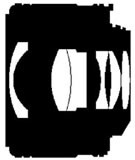 |
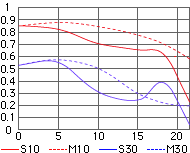 |
Version numbers:- |
| NEXT | Nikon AF Nikkor 50mm standard lenses
![]()
Main Index Page - Autofocus Nikkor lenses
| Message Board |
for your
Nikkor
Optics
in a shared environment
| Message Board | Specifically for Dispose or Looking for new/used Nikon/Nikkor photographic equipment
| Nippon Kogaku Rangefinder Resources | Nikon F | Nikon F2 | Nikon F3 | Nikon F4 | Nikon F5 | Nikon F6 | Nikkormat / Nikomat | Nikon FM Series | Nikon FE/ FA | Nikon EM/FG/FG20 | Nikon Digital SLRs | Nikon - Other models |
Nikon MF RF-Nikkor lenses for Rangefinder
cameras:-
Main Index Page
Nikon
Auto Focus Nikkor lenses:- Main Index
Page
Nikon
Manual
Focus
Nikkor lenses:-
Fisheye-Nikkor Lenses - Circular |
Full Frame |
Ultrawides Lenses - 13mm15mm18mm20mm |
Wideangle Lenses - 24mm28mm35mm |
Standard Lenses - 45mm 50mm 58mm | Telephoto Lenses
- 85mm105mm135mm180mm & 200mm |
Super-Telephoto Lenses - 300mm 400mm 500mm 600mm 800mm 1200mm |
 |
Special Application
lenses: Micro-Nikkor Lenses - 50mm~55mm -60mm 85mm -105mm 200mm Micro-Zoom 70-180mm Perspective Control (PC) - 28mm 35mm PC-Micro 85mm Dedicated Lenses for Nikon F3AF: AF 80mm f/2.8 | AF 200mm f/3.5 EDIF Depth of Field Control (DC): 105mm 135mm Medical Nikkor: 120mm 200mm Reflex-Nikkor Lenses - 500mm 1000mm 2000mm Others: Noct Nikkor | OP-Nikkor | UV Nikkor 55mm 105mm | Focusing Units | Bellows-Nikkor 105mm 135mm Nikon Series E Lenses: 28mm35mm50mm100mm135mm | E-Series Zoom lenses: 36~72mm75~150mm70~210mm |
MF Zoom-Nikkor Lenses: 25~50mm | 28~45mm | 28~50mm | 28~85mm | 35~70mm | 36~72mm E | 35~85mm | 35~105mm | 35~135mm | 35~200mm | 43~86mm | 50~135mm | 50~300mm | 70~210mm E | 75~150mm E | 80~200mm | 85~250mm | 100~300mm | 180~600mm | 200~400mm | 200~600mm | 360~1200mm | 1200~1700mm
Tele-Converters: TC-1 | TC-2 | TC-200 | TC-201 | TC-300 | TC-301 | TC-14 | TC-14A | TC-14B | TC-14C | TC-14E | TC-16 | TC-16A | TC-20E
Recommended links to understand more technical details
related to the Nikkor F-mount and production Serial Number:
http://rick_oleson.tripod.com/index-153.html by: my
friend, Rick Oleson
http://www.zi.ku.dk/personal/lhhansen/photo/fmount.htm by: Hansen,
Lars Holst
http://www.mir.com.my/rb/photography/hardwares/nikonfmount/lens2.htm
http://www.photosynthesis.co.nz/nikon/serialno.html
Recommended Reading Reference on Nikon cameras and Nikkor lenses | about this photographic web site
| | Back | Main Index Page of Nikkor Resources | Back | Main Index Page of Pictorial History of Nikon SLRs |
| Home - Photography in Malaysia |
![]()
Credit: To all the good
people who has contributed their own experience, resources or those who are kind
enough granting us permission to use their images appeared in this site Note:certain
content and images appeared in this site were either scanned from official marketing
leaflets, brochures, sales manuals or publications published by Nikon over the years
and/or contribution from surfers who claimed originality of their work for educational
purposes. The creator of the site will not be responsible for may discrepancies arise
from such dispute except rectifying them after verification."Nikon", "Nikkormat", "Nippon Kokagu
KK"
& "Nikkor" are registered
tradename of Nikon Corporation Inc., Japan. Site made with an Apple IMac.



